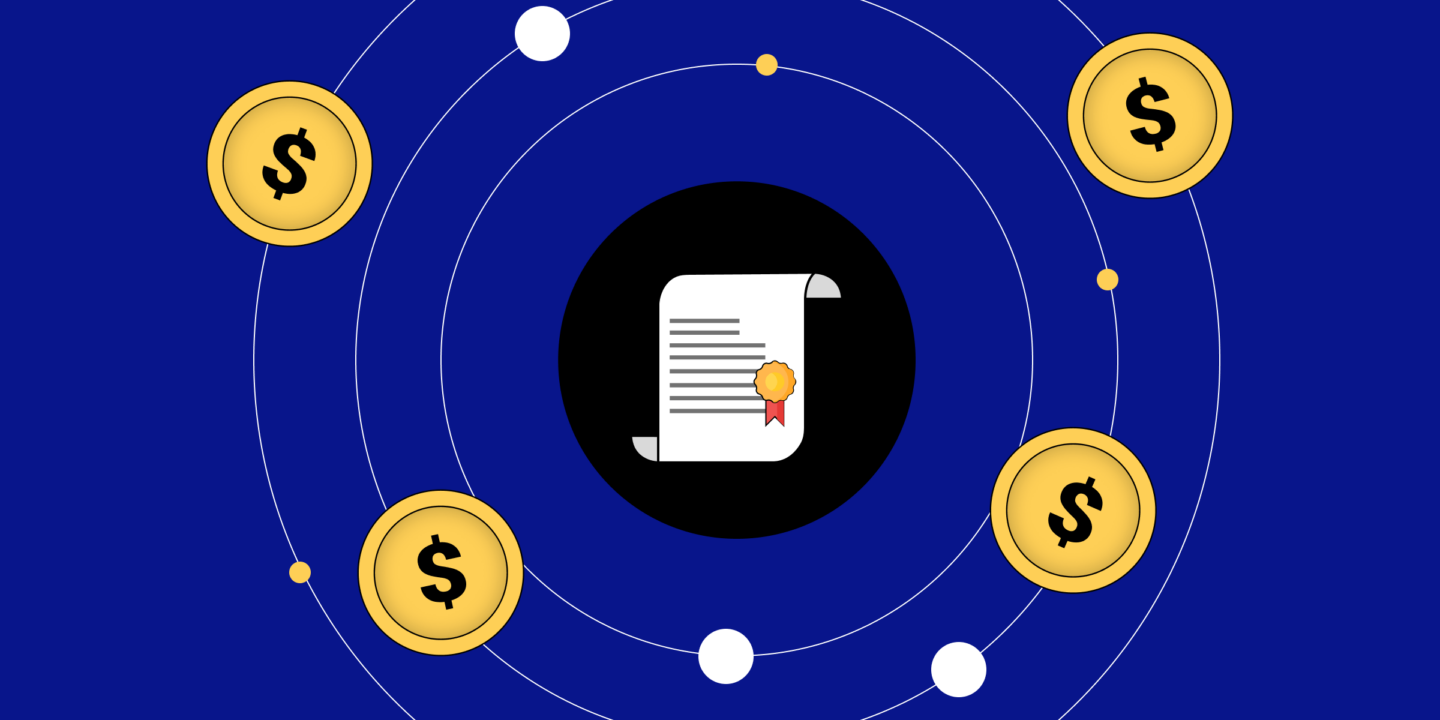
Bonds are fixed-income instruments that help businesses raise capital. Investors buy bonds and fund businesses to earn returns on the same. Think of it as you taking a loan from a bank. You get the funds, and the bank earns interest. Bonds work in a similar manner. However, the tables turn with you being the one lending money.
Bonds are also known as debt instruments as they are debt for the company issuing it. Compared to equity, bonds are cheaper when it comes to the overall cost of capital for the company. Cost of capital refers to the required rate of return that an investor expects to receive on an investment.
With enough being said, let’s dive deeper into what are financial bonds, how they work, and what else you need to know about these instruments.
What Are Bonds in Finance?
Bonds are a type of debt security issued by companies or governments to raise capital from investors as loan. Investors earn a fixed interest rate for buying bonds and lending money to businesses.
Bonds form a massive part of the financial system, and their market is more extensive and profound than the equity market. Government entities like municipalities, state governments, and central governments issue bonds to fund projects like infrastructure, research, development, etc. You need to be prudent enough and know the rationale for lending money to any entity.
A bond can be thought of as an agreement between the borrower and lender that include details like loan amount, repayment terms, the purpose of taking the loan, etc. As an investor, if you subscribe to the bond, it becomes an asset to you as you’d expect to receive a fixed income from it. On the other hand, for the borrower, it is debt.
Investors purchase bonds at face value, which is returned at the end of the fixed tenure. Meanwhile, you can expect fixed interest payments during the tenure.
Bondholders have a legal claim over the assets. Hence in the event of bankruptcy, bondholders receive payment before shareholders. Bonds are included in most investment portfolios to balance out the risk of investing in stocks and other riskier assets.
How Do Financial Bonds Work?
Now that you know what are financial bonds, the next step is to learn how they work and for that you need to know a few terms first.
Face value: The face value of a bond is the price of a single unit of a bond. It is what will be paid back to the borrower once the bond matures. The initial price and the face value of most of the bonds is set at par or in the multiple of thousands. However, the actual market price, may vary due to a number of factors like interest rates, the credit quality of the issuer, tenure of the bond until expiration, and other macroeconomic factors.
Coupon rate: The coupon rate is the interest rate that a bond payes to its holders.
Tenure: It is the time of the total investment period.
Imagine you subscribe to a bond issue having a face value of Rs. 100, and tenure is 2 years with a 5% coupon rate.
In this case, you are entitled to get Rs.5 for 2 years as interest payment and Rs.100 as the principal repayment at the end of 2 years. So, the bonds pay regular interest payments and pay back the principal amount.
It is common for investors to trade bonds and sell them before maturity. However, some investors also hold them until maturity.
Important Types of Financial Bonds
Though bonds are considered one of the safest investment options, there are some bonds that are riskier than others. The riskier the bond the higher the yield and vice versa.
If the issuer is creditworthy and has a higher credit rating then the yields would be lower. If the riskiness of an issuer is higher, the yields are also higher to compensate the investors for taking the risk.
This section will discuss different types of bonds and their issuers to help you understand the levels of exposure you can get.
1. Government bonds
The government of India and other state governments issues these bonds. In the US, they are known as treasury bonds and are viewed as the safest bonds on earth. However, bonds issued by governments of countries like India, Indonesia, Brazil, etc., are perceived to be relatively risky than treasury bonds, and hence investors are compensated with a comparatively higher yield.
Government bonds are issued for overall economic development, infra spending, and other projects, as well as to maintain fiscal prudence.
These bonds can be fixed or floating interest rate bonds. The majority of them are fixed interest rates, where a constant rate is applied throughout the bond tenure.
2. Corporate bonds
Companies issue corporate bonds when they need money. Let’s say a company wants to buy a new factory and expand to increase revenue. They may issue corporate bonds to fund this purchase and pay a fixed interest rate along with the principal amount at the end of the tenure to its investors.
Unlike stocks, buying a company’s bond doesn’t give you an ownership stake in the company. However, as alluded before, in the event of bankruptcy, bondholders are given more priority before stock owners.
Corporate bonds are mainly of two categories: a) High yield and b) Investment grade.
High-yield bonds are lower credit rating bonds and possess a higher risk of default and hence provide higher yields. Investment grade bonds generally have a lower risk of default but their yields are also lower.
3. Municipal bonds
These bonds are issued by municipalities for development and other infrastructure related projects. Municipal bonds are looked at as risk-free investments as quasi-government entities issue these bonds. These bonds are highly rated due to their lower probability of default. In the US, investing in these bonds gives you tax benefits as well.
4. Agency bonds
These bonds are issued by government-affiliated organizations and are among the most low risk bond types. Because, in the worst-case scenario of default, the government is likely to fund these bonds, and give investors their investment back. Agency bonds are not really pure government-issued bonds; however, you can expect to have a sovereign rating close to a government-issued bond.
5. Inflation-linked bonds
As the name suggests, these bonds are designed to track inflation and curb its impact on your investments. Coupon rates and principal are linked to the inflation rates, mainly Consumer Price Index (CPI) and are adjusted accordingly. Here, the bonds work the same as normal bonds, but the principal amount is indexed to reflect inflation.
6. Perpetual bonds
Perpetual bonds are fixed-rate bonds and do not have any maturity period. Investors get fixed interest payments throughout their life. Investors who are in need of fixed payment opt for these bonds. AT1 (Additional Tier 1) bonds issued by banks are perpetual bonds. The investor must do due diligence before investing any amount, as they are riskier than other bonds.
Characteristics of Financial Bonds
The working of bonds can be influenced by some intrinsic factors such as:
1. Face value
It refers to the price of a single unit of a bond issued by the issuer. The alternate names for face value are principal, par, or nominal value. Issuers have a legal obligation to return this value to the investor when the bond matures.
If an investor purchases a bond with a face value of Rs. 10,000, then the issuer is obligated to return Rs. 10,000 along with periodic interest payments to the bondholder.
2. Interest/coupon rate
As we saw before, bonds offer fixed or floating interest payments. These interest rates are also known as coupon rates and are paid periodically. The coupon rate is decided basis various aspects like market interest rates, issuer’s creditworthiness, etc.
3. Coupon dates
Like coupon rates is the interest payment, coupon dates are the dates on which the bond issuer will make interest payments. Frequency can range from monthly, quarterly, semi-annually, and annually. Semi-annually is the standard prevailing in the market.
4. Tenure
Tenure is also known as the maturity date on which a bond will mature. It is the date when the bondholder expects to receive the face value of the bond. Bonds are also classified based on tenure.
Bonds with maturity periods below 5 years are called short-term bonds, whereas a tenure of 5-12 years is attributed to intermediate or medium-term bonds, and bonds with a tenure of more than 12 years are referred to as long-term bonds.
5. Credit quality
It refers to the creditworthiness of the issuer and how the market views them. It determines the degree of confidence investors have in the issuer. Credit rating agencies rate bonds based on the perceived risk of a company not fulfilling its obligations.
Higher credit quality bonds like AAA rated (highest rating) offer lower yields, and lower credit quality bonds like BBB (or below) offer higher yields for compensating the risk being taken. Investors invest in various types of bonds based on return expectations and risk tolerance.
How Are Financial Bonds Valued?
There is so much that goes into determining the intrinsic value of a bond. Knowing the true value of a bond is as important as knowing the value of a business when you invest in equities.
Bond valuation is the process of determining the value of a bond based on the present value of its future cash flows. It is calculated based on the present value of coupon payments using an appropriate discount rate. The discount rate, also called YTM (yield to maturity), is the return that an investor can expect if they reinvest every coupon payment at a fixed rate until the bond matures.
Let’s understand the bond valuation mathematically to see how coupon payments and other things are factored in. Below is the formula for the face value:
Face value = F / (1+r)^t
Whereas,
F = Face value
R = Discount rate, i.e., YTM
T = Time to maturity
The present value of a bond is the current market value of the bond, taking into account the expected cash flows, the YTM, and the time to maturity.
For example, if the face value of a bond is Rs. 1,000, with a YTM of 4%, paying semi-annual interest payments for 3 years:
PV of bonds’ face value = 1000 / (1+2%) ^6 = 888 (rounded off)
Since the bond pays interest semi-annually, a 3-year bond will have interest payments scheduled 6 times, and the same goes for years.
Is Bond Investment a Good Idea?
Bonds, if used prudently along with other asset classes, can be great diversifiers to your investment portfolio. They help limit the downside risk during market turmoil since equity and bonds have a negative correlation. This means if equity falls, bonds rise. Thus, securing your portfolio from falling drastically.
However, as an investor, you must look at what kind of bonds you are investing in and if they suit your objective.
Pros and Cons of Investing in Bonds
Any investment has both pros and cons. Let’s see them in terms of investing in bonds:
Pros of investing in bonds
- Relatively safe investment compared to other riskier investments like equities, commodities, etc.
- Regular interest income to support investors with regular cash flow.
- Helps in diversifying portfolios and reduces the risk.
Cons of investing in bonds
- Returns are lower relative to other assets like equities.
- Interest rate and other macroeconomic variables to pay attention to as they pose a significant risk to bond price.
- The issuer might default and write off the entire bond investment, which can be daunting for investors. (e.g., Yes bank AT1 bonds)
Conclusion
Bonds as fixed-income instruments have been in existence longer than equities. Investing in bonds can play a huge role in achieving a balanced investment portfolio. If you are risk-averse, you should consider investing in bonds.
FAQs
1. Do bonds pay interest annually?
Yes, bonds typically pay interest annually, however the frequency can vary from monthly, quarterly, bi-annually, and annually. The interest payment is also called the coupon payment.
2. Are bond investments tax-free?
Bond investments can be tax-free based on which bonds you invest in. While you need to pay capital gains tax on the bonds, a few bonds, like Tax-saving Bonds or Tax-free Bonds, can help you save on taxes. It depends on which bonds you are choosing to invest in.
3. How can you lose money in bonds?
Bonds are considered as one of the safest investment options, but they are not completely risk-free. If you invest in a low-rated corporate bond, there are chances that the issuing company might default and you may lose your funds. However, this can be avoided by investing in top rated bonds.




